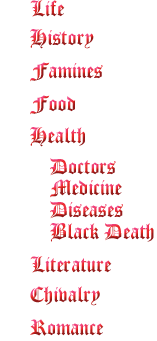 |
|||
 

|
Black Death A medieval nightmare-a time of horror. Imagine walking down the street, and every fourth person you saw would die within three years. The Black Death, ravaging medieval Europe from late 1347 through early 1351 wiped out nearly one-fourth of the continent's inhabitants. Medieval cities fared much worse. With their narrow streets making transmission of the disease much easier, nearly half of the populations of some larger cities perished from this epidemic. The Black Death's origins were from Asia, where it decimated the population there as well, and was brought to Western Europe along trading routes, first arriving in Sicily in 1347. This disease was spread primarily through rats and fleas. The disease attacked lymph, respiratory and/or
circulatory systems and there was nearly a 100% mortality rate for those
infected. The Church's stranglehold on society left many feeling that
this was a plague from God, and that doctors would be of little use. A
chilling rhyme would evolve from the symptoms of the dying and sentiments
of the living… Attempts to avoid the disease ranged from constant supplication to God, to eating fine meats, drinking fine wines, and filling the mind with thought of anything, other than death. Doctors tried to treat victims with everything from valerian root and moonwort, to arsenic and brimstone. The Black Death had a steamroller effect throughout all society. Multitudes of houses and barns infested with rats were left vacant, making it impossible to collect rents. Unused mills fell into disrepair, making it impossible to grind wheat for flour in some areas. There was a resurgence of the disease later in the century, but not as many people were infected. |
 |
|
 |
|||
 |
|||